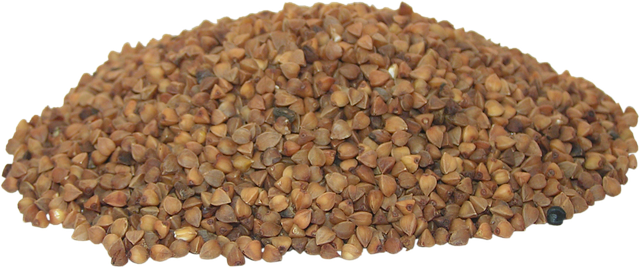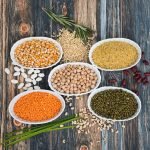
Good, energizing and nutritious, buckwheat is an excellent substitute for wheat, suitable for everyone and particularly suitable for celiacs. Let’s discover its properties and benefits.
Buckwheat, whose scientific name is Fagopyrum esculentum, is a herbaceous plant available all year round, belonging to the Polygonaceae family. The beans have a characteristic triangular shape and a greyish color, sometimes tending to brown.
In spite of the name, it has nothing to do with the wheat used for the production of pasta, but it is a pseudocereal and has characteristics similar to cereals (wheat, rice, barley, etc …) and to legumes (lentils, chickpeas, beans, etc. …); it is, in fact, a food composed mainly of complex carbohydrates and vegetable proteins. One of its peculiarities is the total absence of gluten so it can be used by celiacs.
Buckwheat has oriental origins; starting from the fourteenth century, then, it began to be imported in the most western countries, arriving in Italy thanks to maritime trade through the Black Sea. In the Belpaese the largest crops are located in South Tyrol, Valtellina, Tuscany and Umbria, thanks to which it is possible to taste the famous polenta taragna and the characteristic pizzoccheri. Let’s now take a look at the properties of buckwheat and its nutritional values.
Buckwheat: calories and nutritional values
Let’s start by seeing how many calories this food brings. Specifically, 100 grams of buckwheat bring about 343 kcal, a value in line with other foods in its same category (whether they are cereals or pseudocereals), therefore it is not a particularly caloric food.
Relative to macronutrients, buckwheat mainly contains carbohydrates, which make up about 70% of its weight. Also excellent is the intake of fiber (10%) and proteins, contained in greater quantities than cereals. Specifically, buckwheat is an excellent source of essential amino acids, so defined because they are not produced independently by the body, but of significant biological importance: the main ones are lysine, tryptophan and threonine.
Furthermore, there is no shortage of vitamins (A, B1, B2, B3, B5, B6 and K), mineral salts, among which magnesium and potassium stand out, then calcium, phosphorus, zinc, and antioxidants, such as rutin, quercetin and vitexin.
Nutritional values per 100g of buckwheat:
- Waterfall: 9.7 g
- kcal: 343
- Proteins: 13.2 g
- Fat: 3.4 g
- of which saturated: 0.74 g
- Carbohydrates: 71.4 g
- of which sugars: 0 g
- Fibers: 10 g
- Potassium: 464 mg
- Glycemic index: 50
- Cholesterol: 0 g
Buckwheat: the health benefits
Its particular composition and the presence of antioxidants and precious vitamins, give buckwheat useful properties for the well-being of the whole organism, helping to prevent different pathologies. In short, it is good for the heart, has antioxidant properties, regulates the intestine, helps in case of diabetes and is useful in slimming or vegan diets, but not only. Let’s see all the benefits in detail.
✓ Improves blood microcirculation
Buckwheat, as we have seen, contains rutin, a fundamental antioxidant in protecting cells from free radicals, but not only: it is well known especially for its anti-haemorrhagic activity and for the regulation and improvement of the permeability and elasticity of blood capillaries, with a positive effect on the entire circulation. Furthermore, the antithrombotic and antiplatelet properties of buckwheat, making the blood more fluid, prevent the formation of thrombus and therefore the risk of heart attacks or strokes.
✓ Prevents atherosclerotic diseases
The flavonoids contained in this cereal, such as quercetin and vitexin, prevent lipid peroxidation, one of the basic mechanisms in the production of atherosclerotic plaques on the vessel walls.
✓ Helps against water retention and hypertension
The mineral salts present in buckwheat, especially potassium, stimulate diuresis and fight water retention, helping to keep blood pressure under control.
✓ Improves bowel regularity and lowers cholesterol
Buckwheat contains a good dose of fiber which, on the one hand, facilitate and regulate intestinal transit, and on the other, help to limit the amount of cholesterol that can be absorbed by the body.
✓ Help against diabetes
Buckwheat, unlike the more common starchy foods, has a lower glycemic index and gives a greater sense of satiety. Furthermore, some researches propose the important role played by an active ingredient contained in it, the D-chiro-inositol: it would, in fact, be able to increase the responsiveness of cells to insulin, decreasing the amount of sugars in circulation.
✓ Energizing properties
Buckwheat has energizing properties. The presence of proteins, essential amino acids and many mineral salts in fact, makes buckwheat a food of choice for athletes, in states of fatigue and physical decline, and in all those cases where it is necessary to give more energy, such as pregnancy.
✓ Ally of the diet
Thanks to the satiating power and the low calories introduced per 100g of product, buckwheat enters fully into the ideal diet of those who intend to lose weight, while vegetarians and vegans (but not only!) Can draw from it important proteins not of animal origin, preventing any food shortages.
How much buckwheat to eat
Due to its nutritional properties and the wide use that can be made of it in the kitchen, buckwheat is comparable to cereals in terms of use and portions to be consumed. Specifically, the recommended portion of buckwheat is 80 grams (weight referred to raw food) and provides about 275 kcal. As part of a varied and balanced diet, buckwheat can also be consumed several times a week, possibly alternating with other cereals and pseudocereli (such as quinoa or amaranth) to prepare first courses, soups or salads.
Whole and hulled buckwheat: which one to choose
To understand the difference between whole and hulled buckwheat it is necessary to make a premise on the structure of the grain which, from the outside to the inside, is formed by three layers: bran, germ and endosperm.
When the grain is complete with the three layers it is whole buckwheat, while when the grain is processed and without the bran it becomes hulled buckwheat. By keeping all the parts of the grain, whole buckwheat certainly has a higher fiber content, however it can be more difficult to use in the kitchen due to the excessive resistance of the external bran (which can be rubbery even after soaking and cooking) and it is mainly used for the preparation of flour.
If used in the form of grains, therefore, the hulled version is more versatile and is the one generally referred to when talking about buckwheat grains.
Buckwheat: tips for using it in the kitchen
As we saw above, buckwheat is generally found on the market in the form of grains or flour.
The seeds are used in the kitchen for the preparation of first courses, soups, soups, vegetarian meatballs, or added, individually or together with other cereals for the preparation of salads. Before using buckwheat it is good to wash the grains under running water. The cooking will then be done, using two parts of water for each part of buckwheat. The cooking time is about 20-30 minutes from boiling.
Buckwheat flour, on the other hand, thanks to its nutty flavor, makes every recipe special. With it you can prepare different dishes from sweet to savory, such as gluten-free bread, polenta, pies, crepes and pancakes. It is also possible to create flour mixes, for example by combining wholemeal flour and buckwheat flour, to give a more rustic flavor to our baked preparations.
Contraindications of buckwheat
As with all foods, also for buckwheat it is necessary to pay attention to the development of any intolerances or allergies towards the food: in such cases, its use is obviously not recommended. In addition, buckwheat is one of the cereals with the highest nickel content, to be taken into consideration if you have a nickel allergy.
In subjects who resort to anticoagulant therapy, the ingestion of buckwheat should be limited due to its anti-haemorrhagic properties and the presence of vitamin K.
Where to buy buckwheat and useful tips
Buckwheat can be found in supermarkets, organic shops or online. It is possible to buy buckwheat in grains, in flour or already transformed into pasta. This food is mainly produced in Russia and China, while in Italy the cultivation of buckwheat is still a niche production coming especially from Lombardy, South Tyrol, Tuscany and Umbria.
Curiosity
Buckwheat flour, spread on the body and kept on for a quarter of an hour before being rinsed, is a small and precious beauty pamper, leaving the skin smooth and pleasantly scented.






